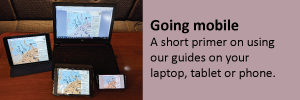Stern-tie angst

Even the smallest anchorages can feel expanssive when all vessels stern tie. (Photo by Wilf Ratzburg)
You take a deep breath, or you don’t, depending on your nautical politics, and you ask: “Why?”
The answer usually falls somewhere in between two responses, which can be loosely interpreted as: “it’s too much trouble” or “I got here first. Get your own anchorage.”
In some tight anchorages, it’s selfish. You are first to arrive, you own the little cove, swinging like a big bird and making it impossible for late arrivals to find secure moorage, whether stern tied or not.
In Desolation Sound, in the park, they make it easy. The government, and good folks like Marine Parks Forever, pound metal rings into the rock from which they sometimes hang chains, making it so simple, even morons like me can stern tie, though many still don’t.
In the Broughtons, it’s a little less paint by numbers, with no rings pounded into rock and painted electric lime telling you to “tie here”. It requires you to have a sense where to tie given the forecast winds. And unlike farther south in the Salish Sea, the wind seems to be blowing here more often than not, mostly from the northwest, though often from the southeast, sometimes with brute force.
So no matter where you are in the Broughtons and nearby, you are thinking generally about protection from the northwest, while knowing where you can find shelter from southeast winds if necessary. The beauty of stern tying is that you can pull up into the lee of the tiniest islet to protect from whatever direction the wind is forecast to come.

This is true also of many popular anchorages oriented to protect against northwest winds, pulling snugly into the shortest bit of protected shoreline while the anchorage empties as boaters disappear in search of conventional protection from southerly winds, and it continues to be a lonely place as long as contrary winds continue to blow.
Stern tying provides so many options for boaters, finding the right equipment for you and your boat is sometimes not easy. Every boat is different. It requires a secure line, with an easy way to store and deploy it.
There are many possible configurations, store bought or DIY. Some store-bought spools come empty, ready to be filled with lines of your choice, floating of course. Some come filled with nylon or poly-something-or-other, or fabric, the latter being very fancy and costly, but it takes a very large spool to hold a very long fabric line.
So get a strong line, one that floats to minimize recovery or propeller issues. The line should be a minimum of 100-150 metres (330-500 feet) long, longer the better, so if you have to anchor a ways off shore you still can run a line to shore, around a tree or through a mooring ring and lead the line back to the boat. The beauty of this is that when you depart, you can untie the line and pull it in without leaving the boat.
Practice. Anchor off the shore, making sure the hook is well set. Maintain a short scope so your vessel will not drift close to other vessels in the anchorage. Jump in your dinghy, stick the line between your knees or wherever and row to shore as the line unspools. If there is no mooring ring, look for a tree or log that is close to shore, strong and less likely to snag the line when you attempt to recover it from the boat.
Run the line back to a cleat on the boat. Snug it taunt. Release some anchor rode. Snug the stern line again. This way you can control how close to shore your boat sits. Make sure you know the state of tide and monitor depths with your sounder.
Presto. We have found it just as easy whether single or double handed. Recently, off the tiny islet in the busy Goat Island anchorage in the Broughtons, singlehanding I dropped a kedge off the stern so I would not swing into another vessel in the channel. Probably didn’t need it, but I felt safer.
It is more complicated anchoring in many of the long and deep inlets in the Salish Sea. The bottom is often so steep that you will position your boat close to shore, drop 40 metres (130 feet) of anchor and chain from the bow, and it will not find bottom until your boat’s hull is almost touching the shore.
Even where you are expected to shore tie, such as Queen Charlotte Inlet, there are rings in which we hang 50 metres (164 feet) of chain from the bow before we back toward shore.
There is a park dock here, but if its full, it’s best to be prepared.


















